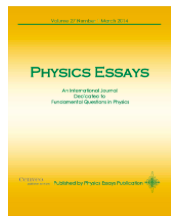Theory Papers
Paramahamsa Tewari has published books, as well as several important theory papers and thought pieces related to his discoveries.
|
Read Paramahamsa Tewari's last published theoretical paper - Structural relation between the vacuum space and the electron - published in the reputed publication Physics Essays - An International Journal Dedicated to Fundamental Questions in Physics. You can purchase on the Physics Essays website. Published by Physics Essays Publication through Cenveo Publisher Services. Copyright 2018 Physics Essays Publication.
|
Paper - "The Space-Vortex Structure of The Electron", based on his SVT theory, in the journal, Apeiron.
Limitations of Quantum Theory
Explaining Momentum, Kinetic Energy, Inertia through Principles of Space Vortex Theory (SVT)
Notes on Spatial Reality and Property of Vacuum
Relativity Theory Is Not A Comprehensive Theory
Colliding Galaxies (graphic below)
The Universe: Finite or Infinite?
Creation of Matter at the Center of the Galaxy
The So Called Dark Matter
Time Dilation in Relativity Theory
Planck’s Constant and the Photon
Questions and Answers on Space Vortex Theory
Abolition of “Action at a Distance”
Spatial Forces of Energy
The Hidden Laws in the Universe
Explaining Momentum, Kinetic Energy, Inertia through Principles of Space Vortex Theory (SVT)
Notes on Spatial Reality and Property of Vacuum
Relativity Theory Is Not A Comprehensive Theory
Colliding Galaxies (graphic below)
The Universe: Finite or Infinite?
Creation of Matter at the Center of the Galaxy
The So Called Dark Matter
Time Dilation in Relativity Theory
Planck’s Constant and the Photon
Questions and Answers on Space Vortex Theory
Abolition of “Action at a Distance”
Spatial Forces of Energy
The Hidden Laws in the Universe
Conceptual Error On The Fundamental Nature Of Light – Phenomenon In Classical Electrodynamics, Led To The Complexities In Quantum Physics
Introduction
James Clerk Maxwell (1831-1879) had theoretically concluded that the oscillations of electric current in a straight conductor, or circulation in a loop of wire, “radiates away” energy, which is “lost” from the oscillating charges constituting the current. This concept, later, conflicted with the atom’s model of Rutherford in which electrons moved around the nucleus in closed orbits; and the question arose that like any other vibrating or revolving charge, the electrons should lose energy by emitting electromagnetic waves as per the classical electrodynamics, eventually falling into the nucleus. The quantum theory of light by Planck and Einstein had accepted the possibility of “emission” and “absorption” of light by electron; the atomic model of Bohr attempted partial solution to the aforesaid problem. However, it is shown in this paper through the space-vortex structure of electron, which provides deeper insight into the basic nature of mass, inertia, energy, electrical charge and light; that during vibration, or revolution around a center , an electron does not lose either its structural or kinetic energy; though it produces electromagnet field (light), which is shown to be created due to mere cyclic changes in the magnitudes of its electrostatic and gravitational potentials in space; on account of to-and-fro displacement of the electron’s center(discussed further). Thus, if loss of energy from the orbital electrons in an atom can be shown to be non existent, similar to the solar system in the Rutherford’s model of atom, the revolving electrons will have stable elliptical orbits; and this would lead to the right course of development of the atomic physics, provided an alternative explanation for the production of light from the vibrating atoms (rather than the orbital electrons) is given. The physical aspects of the process of electron’s creation and annihilation, wave length and frequency of light, briefly outlined in this paper (from author’s earlier works), enable drawing comparison with the corresponding ideas of quantum physics and, thereby, tracing down those phenomena of quantum theory that led to digressions, one after the other, from reality in the early years of this century.
James Clerk Maxwell (1831-1879) had theoretically concluded that the oscillations of electric current in a straight conductor, or circulation in a loop of wire, “radiates away” energy, which is “lost” from the oscillating charges constituting the current. This concept, later, conflicted with the atom’s model of Rutherford in which electrons moved around the nucleus in closed orbits; and the question arose that like any other vibrating or revolving charge, the electrons should lose energy by emitting electromagnetic waves as per the classical electrodynamics, eventually falling into the nucleus. The quantum theory of light by Planck and Einstein had accepted the possibility of “emission” and “absorption” of light by electron; the atomic model of Bohr attempted partial solution to the aforesaid problem. However, it is shown in this paper through the space-vortex structure of electron, which provides deeper insight into the basic nature of mass, inertia, energy, electrical charge and light; that during vibration, or revolution around a center , an electron does not lose either its structural or kinetic energy; though it produces electromagnet field (light), which is shown to be created due to mere cyclic changes in the magnitudes of its electrostatic and gravitational potentials in space; on account of to-and-fro displacement of the electron’s center(discussed further). Thus, if loss of energy from the orbital electrons in an atom can be shown to be non existent, similar to the solar system in the Rutherford’s model of atom, the revolving electrons will have stable elliptical orbits; and this would lead to the right course of development of the atomic physics, provided an alternative explanation for the production of light from the vibrating atoms (rather than the orbital electrons) is given. The physical aspects of the process of electron’s creation and annihilation, wave length and frequency of light, briefly outlined in this paper (from author’s earlier works), enable drawing comparison with the corresponding ideas of quantum physics and, thereby, tracing down those phenomena of quantum theory that led to digressions, one after the other, from reality in the early years of this century.


